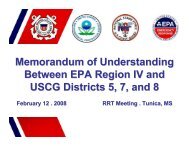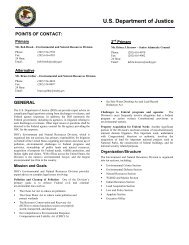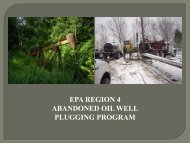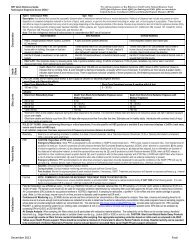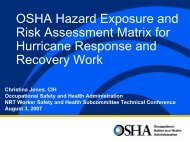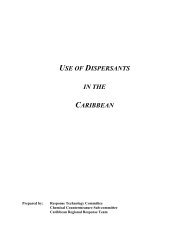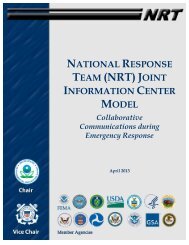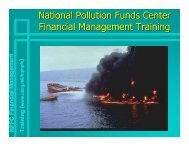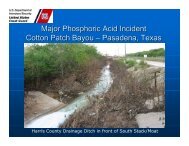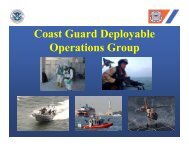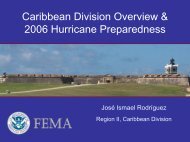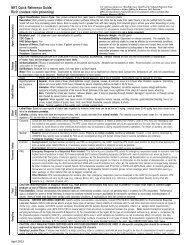Seventh Coast Guard District - U.S. National Response Team (NRT)
Seventh Coast Guard District - U.S. National Response Team (NRT)
Seventh Coast Guard District - U.S. National Response Team (NRT)
You also want an ePaper? Increase the reach of your titles
YUMPU automatically turns print PDFs into web optimized ePapers that Google loves.
U. S. <strong>Coast</strong> <strong>Guard</strong> <strong>District</strong> Seven<strong>District</strong> <strong>Response</strong> Advisory <strong>Team</strong>(DRAT)
EXXON VALDEZ● The T/S EXXON VALDEZ strikes Bligh Reef 24 March 1989.● 11 million gals of crude oil spill into Prince William Sound.Initial clean up costs exceed $2.1 billion & costs continue.Staggering wildlife losses (waterfowl deaths alone exceed250,000 birds, total animal deaths will never be known).Public concern over slow & inadequate response promptsCongress to legislate the Oil Pollution Act of 1990 (OPA 90).● OPA 90 requires the <strong>Coast</strong> <strong>Guard</strong> to form <strong>District</strong> <strong>Response</strong>Groups (DRGs) & funds $30.5 million to buy response equipment.
(A side note) DRGs & DRATs● Congress initially wanted CG Strike <strong>Team</strong>s in each CG <strong>District</strong>.● The CG believed that would be overkill & convinces congress to acceptonly 1 additional Strike <strong>Team</strong>, at Ft. Dix, NJ, and smaller <strong>District</strong> <strong>Response</strong>Advisory <strong>Team</strong>s (DRATS), of 3-6 oil response specialists, at each district.● The CG <strong>District</strong> 7 DRAT is currently composed of a DRAT supervisor, aPREP coordinator and an equipment specialist.● DRATs are responsible for coordinating (DRGs).• DRGs are composed of the entire response community within each<strong>Coast</strong> <strong>Guard</strong> <strong>District</strong>. Includes private & government spill responders.• Private sector responders are called Oil Spill Removal Organizations(OSROs) and include companies such as the <strong>National</strong> <strong>Response</strong> Corp(NRC) and the Marine Spill <strong>Response</strong> Corp (MSRC).
CG <strong>District</strong> 7 DRAT Equipment Capabilities● Spilled Oil Recovery System (SORS)● The CG Spilled Oil Recovery System (SORS) is a modern, highperformance, over-the-side, single ship recovery system, designed for 225foot Juniper Class Bouy Tenders (WLB). The SORS is comprised of 2identical sweeping and skimming systems. Standard operating procedure isto deploy one system on one side and deploy a storage bladder on theother side. 225 ft WLB’s can also store recovered oil in an onboard tank.SORS is packaged in four stackable aluminum containers, which fit into thehold under the main deck. SORS is designed to be installed and operatedby the vessel crew. A trained crew should be able to install SORS in the “intransit” mode in less than one hour.● SORS were required on new WLBs by OPA 90. SORS is similar toVOSS excepting that it uses the ship’s hydraulic rather than the Deutzhydraulic power pack and it is not accompanied by 5,000 ft of extra boom.
CG <strong>District</strong> 7 DRAT Equipment Capabilities● OPA 90 First Aid Equipment● Meant for small spills or as an interim quick response measure, untilOSROs, VOSS or SORS can respond. Valuable training resource formaintaining skills and enables novice response personnel to obtain skills.Original OPA issue (91-93) was 2,000 feet of boom & 2 or 3 trailers per unit.● <strong>District</strong> 7 has implemented a unit level Equipment Manger program.Established unit level POCs for all response equipment coordination.<strong>District</strong> 7 Planning Branch funded training for Equipment Managers atTexas A&M spill school.● Per PREP Guidelines, all Sectors completed required annual equipmentdeployment exercises. Attributable, in part, to Equipment Managerprogram.● <strong>District</strong> 7 has aggressively replaced all but 2 of the original 21 OPA 90
CG <strong>District</strong> 7 DRAT Equipment Capabilities● Airborne Dispersant Delivery System (ADDS)● CG <strong>District</strong> 7 has a signed Memorandum of Agreement (MOA) withClean Caribbean Americas (CCA) to provide limited cooperation forairborne dispersant ops. Depending on conditions, <strong>District</strong> 7 may provideC-130 aircraft and CCA may provide a 5,500 gal ADDS Pack. Might be thebest option for some offshore spills.● CCA’s ADDS Pack has a max capacity of 5,500 gals of dispersant.Depending on distance to spill site, a C-130 with ADDS could spray up to55,000 gals of dispersant in a 10 hr period.● Doseage: 2-10 gals of dispersant per acre or volume of oil to volume ofdispersant range of 100:1 to 10:1 for thicker oil. CCA keeps a ready stockof 30,000 gals of COREXIT EC 9500 A in FT. Lauderdale.● Concerns: MOA currently being re-written, limited availability of aircraft.
PICTURE TIME



